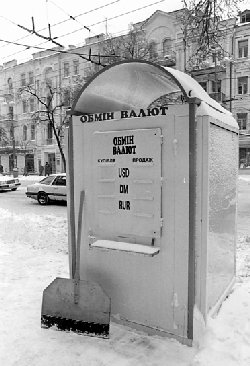Was it let loose because there was no strength to support it?

Last Thursday may become a notable milestone in the history of our national currency. Deputy Premier and one of the probable candidates for Prime Minister, Serhiy Tyhypko, announced, for the first time, changes in currency policy. According to him, the currency policy in Ukraine “is currently not realistic, that is, it does not exist in fact.” Then he explained in simple terms the reason: “It is impossible to long pursue a currency policy by administrative methods or some prohibitions, for this will be felt by the real economic sector and banking system.” Hence, he concludes, “It is obvious to me that the existing currency policy should be changed.”
However, it is not quite clear even to the government member in charge of the economic matters himself in what direction the changes will go. Among possible options, he named a free exchange rate, a stringent rate, and a creeping pegged rate (pegged on inflation, the euro, or the dollar, Interfax- Ukraine explains). Mr. Tyhypko did not disclose the dates when a new currency policy will be introduced, but he noted that it will be announced in a joint statement by the government and the National Bank. And there must be some mutual understanding with the latter, for National Bank Governor Viktor Yushchenko admits, “Ukraine has been in fact living with a floating- rate policy” since March this year, and Mr. Tyhypko himself asserts that it is the National Bank that must play “first violin” in determining future currency policy.
A slightly more complicated situation is with the position of the Ministry of Finance which does not seem so far to be losing ground in the currency orchestra. In a newspaper interview, Minister Ihor Mitiukov promised to keep the hryvnia within the set band until yearend and said it was easier for him to pay 300 million to the National Bank to enable it to withdraw this hryvnia and bring the rate back into the corridor than to pay next year another 3 billion hryvnias of rate difference to service the foreign debt. Moreover, the average annual hryvnia rate (5 to $1) the Ministry of Finance put in the 2000 budget can only testify that this agency is not mature enough to change its currency policy.
Meanwhile, International Monetary Fund senior representative in Ukraine Henri Guesquierre, addressing a Ukrainian-German economic forum, said, “The problem of foreign debt servicing does not leave (Ukraine —Ed. ) time for delay,” Ukrayinski Novyny reports. According to Mr. Guesquierre, “It will take 100 days or even more to implement the components of an ambitious reform plan even if there is a strong political will. With due account of the hard task Ukraine faces, there are no grounds whatever to postpone such efforts. The first weeks are critical to convince Ukrainians and foreign investors with actions, and not words, that this time it is in earnest.”
The behavior of the hryvnia, which continues to sink slowly but steadily on the interbank market, approaching the mark of five to the dollar, testifies that there is indeed very little time left for making serious decisions.
Vyacheslav YUTKIN, deputy chairman of the National Reserves Bank and head of its representation in Ukraine:
It is hard to picture the hryvnia getting back within the limits of the currency trade band (UAH 4.60 to the dollar), because there are no economic prerequisites. There do seem to be political ones. The emission undertaken for reasons we all know upset the hryvnia balance and correcting it is a problem that cannot be solved in practice. The market situation shows that the Ukrainian currency is slowly but surely approaching the hard cash market rate, in other words, daily devaluation. The only question remaining open is how quickly the official exchange rate will surmount the five to the dollar barrier, whether on January 1 or in the last ten days of December. I believe that the next year’s average rate will be 5:1, if there are no market upheavals. It is also true, however, that most experts are hard put to analyze the public debt situation which is, of course, the crucial factor for exchange rates. And the same is true of most of Ukraine’s creditors, both private and international financial institutions. In a word, making forecasts at this point is very difficult. Jumps either way are possible, but a degree of political stability certain to set in after the elections will keep the hryvnia at the 5.50 level, while 5:1 is simply unreal. One cannot expect the hryvnia to keep within the currency trade band limits after getting above 5:1 rate in mid-2000. Moreover, most Ukrainian and Western economists agree that the trade band policy has no prospects after its second fiasco. Being ineffective, it can only damage Ukraine’s political and credit history. Declaring a new currency trade band only to breach it again is clear evidence that there are no real guarantees.
As a representative of a bank ranking among Ukraine’s most important creditors (and I am talking half a billion dollars), I think that the most saddening thing about the hryvnia is that it is sustaining the heaviest pressure in terms of investment climate from the ambiguous public debt situation. You might not find a single creditor who will explain this situation starting in 2000. Will Ukraine pay its debts? How certain can one be of it? If so, how regular will such payments be? All countries under similar pressure have been actively negotiating the situation with their creditors for the past six months. In Ukraine, it’s all talk and declarations of good intentions. Of course, the presidential campaign was a strong distracting factor, yet the current situation is truly alarming. It will be influenced by two factors: absence of fresh loans and uncertain payback status. The hryvnia could well buckle under such heavy blows, dropping to 5.60 and even lower. We hear the Finance Ministry’s assurances about getting the national currency back within the trade band limits. The question is how to do it. By restructuring 2000 payments? Great! But there is no movement in that direction. Instead, there is concern about foreign debt payments, thus doubling inflationary expectations, making businessmen and pensioners hurry to convert their hryvnias into dollars.
Bohdan HUBSKY, deputy chairman of the Verkhovna Rada budget and finance committee:
Ukraine won’t pay its foreign debts, because there is nothing to pay with. If we keep buying hard currency on the exchange and debt payment market, it means that hard currency demand will have to rise, and so will the exchange rate. Thus we should first restructure our debts; second, we should make every effort to increase budget revenues. This calls for enacting a tax code on a top priority basis, along with a public debt law. At present, we cannot clearly formulate our attitude toward this issue, because there is no legal regulation whatsoever. And so we have to negotiate while boosting budget revenues and curbing expenditures. Our budget has two sources of debt payments: spending less on agribusiness and industry and privatization proceeds. The latter are planned to be four times last year’s. Considering that the investment climate hasn’t changed, this looks pretty dubious. Hence, we should improve our tax laws immediately and enact a tax code. What investor will think of buying our factories without being certain that taxes will not change tomorrow? Monetary policy is a complicated matter where everything is interrelated. Yet if you try to solve it by just buying hard currency the exchange rate will soar, no doubt about it. Let me say again that the hryvnia will be stable if we carry out a complex of measures: (a) restructure our debts, (b) legally regularize the problem of debts by enacting an appropriate law, and (c) providing a favorable business climate by enacting a tax code, thus securing additional tax revenues.
Yaroslav SOLTYS, deputy chairman of the board, National Bank of Ukraine:
We are focused on the currency trade band, yet the hryvnia rate is not firmly attached to it and has exceeded band limits. Later, this rate will become the market one, while still regulated by the National Bank using market methods, as before. There will be a floating currency trade band of sorts. We have a certain strategy to follow to the end of the year. We are also working on a new ideology and strategy. However, it would be premature to say that this strategy is ready. Life shows that the hryvnia rate cannot be tied and held fast. There are fluctuations regardless of the monetary circumstances and techniques employed. Remember the fuel price jump? It happened because gasoline market supply dropped four times. Thus keeping the rate as it was and allowing fuel black marketers to make easy dollars would have been highly improper. It was thus that we allowed the hryvnia out of currency trade band, but then it was brought back. Hence, monetary policy depends not only on what the National Bank does, but largely on the overall economic condition. Today I can state that we do not have spare hryvnias in turnover, allowing the national currency out of the band, yet I am not sure that the hryvnia will return to it; however, it will not go far beyond its limits.
Newspaper output №: Section






